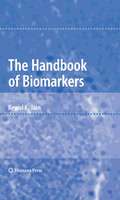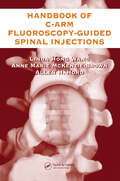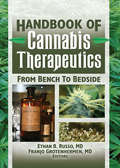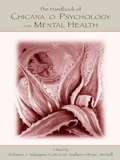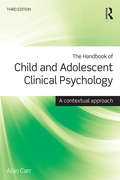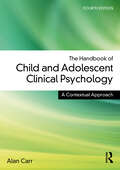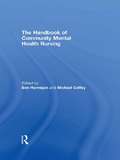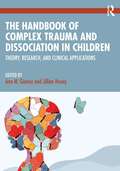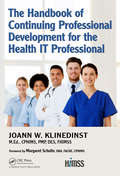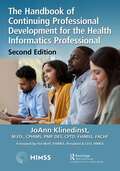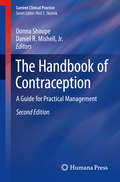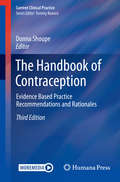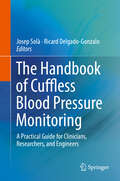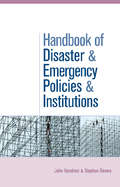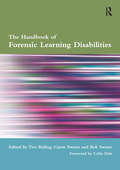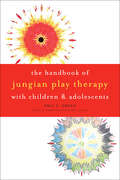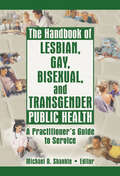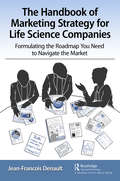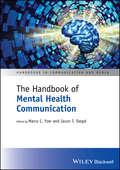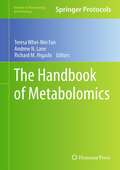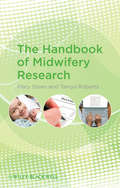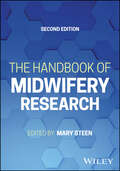- Table View
- List View
The Handbook of Biomarkers
by Kewal K. JainOf the thousands of biomarkers that are currently being discovered, relatively few are being validated for further applications, and the potential of a biomarker can be quite difficult to evaluate. To aid in this imperative research, Dr. Kewal K. Jain's Handbook of Biomarkers thoroughly describes many different types of biomarkers and their discovery using various "-omics" technologies, such as proteomics and metabolomics, along with the background information needed for the evaluation of biomarkers as well as the essential procedures for their validation and use in clinical trials. With biomarkers described first according to technologies and then according to various diseases, this detailed book features the key correlations between diseases and classifications of biomarkers, which provides the reader with a guide to sort out current and future biomarkers. Comprehensive and cutting-edge, The Handbook of Biomarkers serves as a vital guide to furthering our understanding of biomarkers, which, by facilitating the combination of therapeutics with diagnostics, promise to play an important role in the development of personalized medicine, one of the most important emerging trends in healthcare today.
The Handbook of C-Arm Fluoroscopy-Guided Spinal Injections
by Linda Hong Wang Anne Marie McKenzie-Brown Allen HordFor some time now, C-arm fluoroscopy-guided spinal injections have been performed widely for both the diagnosis and management of spinal and paraspinal pain. Despite this common use, many residents and pain fellows do not receive formal training in the anatomy of the vertebral column as it relates to radiographic imaging, nor do they receive any tr
The Handbook of Cannabis Therapeutics: From Bench to Bedside
by Ethan B. Russo Franjo GrotenhermenLearn the facts behind the pharmacology and pharmacokinetics of controversial cannabis therapeuticsThe Handbook of Cannabis Therapeutics: From Bench to Bedside sets aside the condemnation and hysteria of society&’s view of cannabis to concentrate on the medically sound aspects of cannabis therapeutics. The world&’s foremost experts provide a reasoned, thoroughly researched overview of the controversial subject of cannabis, from its history as a medicine through its latest therapeutic uses. The latest studies on the botany, history, biochemistry, pharmacology, toxicology, clinical use for various illnesses such as AIDS, epilepsy, and multiple sclerosis, and side effects of marijuana are all examined and discussed in depth. This comprehensive resource is a compendium of articles from the Journal of Cannabis Therapeutics-with additional contemporary commentary. It presents startling research that explores and supports the medicinal value of cannabis use and its derivatives as a valid therapeutic resource for pain and inflammation, for several illnesses less responsive to other therapies, and even for certain veterinary uses. Cannabinoids such as nabilone, THC, levonantradol, ajulemic acid, dexanabinal, and others are extensively described, with a review of new indications for cannabinoid pharmaceuticals. The book is carefully referenced to encourage your examination of previous studies and provides tables and figures to enhance understanding of information.The Handbook of Cannabis Therapeutics discusses: the uses of cannabis in Arabic, Greek, Roman, and early English medicines absorption rates pharmacokinetics pharmacodynamics separate extracts versus the use of cannabis in its entirety the therapeutic value of the endocannabinoid system cannabinoids and newborn feeding a comparison of smoking versus oral preparations clinical research data on eating cannabis therapeutic uses as appetite stimulant treatments in obstetrics and gynecology medicinal treatments used in Jamaica the use of cannabis in the treatment of multiple sclerosis the benefits versus the adverse side effects of cannabis useThe Handbook of Cannabis Therapeutics is a reference work certain to become crucial to physicians, psychologists, researchers, biochemists, graduate students, and interested members of the public.
The Handbook of Chicana/o Psychology and Mental Health
by Brian W. McNeill Roberto J. Velásquez Leticia M. ArellanoMexican-Americans now constitute two thirds of what has become the largest and fastest-growing minority group in the United States, Hispanics. They have distinct cultural patterns and values that those who seek to serve them competently as clinicians and educators, and those who attempt to study them, need to understand. This is the first comprehensive overview of the psychology of the Chicana/o experience since 1984. Solidly grounded in the latest theory and research, much of which is relevant to other Latina/o groups as well, The Handbook of Chicana/o Psychology and Mental Health is an indispensable source of up-to-date information and guidance for mental health and education professionals, their trainees and students; and for social and behavioral scientists interested in the impact of cultural differences in multicultural settings.
The Handbook of Child and Adolescent Clinical Psychology: A Contextual Approach
by Alan CarrThe third edition of the hugely successful Handbook of Child and Adolescent Clinical Psychology incorporates important advances in the field to provide a reliable and accessible resource for clinical psychologists. Beginning with a set of general conceptual frameworks for practice, the book gives specific guidance on the management of problems commonly encountered in clinical work with children and adolescents drawing on the best practice in the fields of clinical psychology and family therapy. In six sections thorough and comprehensive coverage of the following areas is provided: Frameworks for practice Problems of infancy and early childhood Problems of middle childhood Problems of adolescence Child abuse Adjustment to major life transitions Thoroughly updated throughout, each chapter dealing with specific clinical problems includes cases examples and detailed discussion of diagnosis, classification, epidemiology and clinical features. New material includes the latest advances in: child and adolescent clinical psychology; developmental psychology and developmental psychopathology; assessment and treatment programmes. This book is invaluable as both a reference work for experienced practitioners and as an up-to-date, evidence-based practice manual for clinical psychologists in training. The Handbook of Child and Adolescent Clinical Psychology is one of a set of 3 books published by Routledge which includes The Handbook of Adult Clinical Psychology: An Evidence Based Practice Approach, Second Edition (Edited by Carr & McNulty) and The Handbook of Intellectual Disability and Clinical Psychology Practice (Edited by Alan Carr, Christine Linehan, Gary O’Reilly, Patricia Noonan Walsh and John McEvoy).
The Handbook of Child and Adolescent Clinical Psychology: A Contextual Approach
by Alan CarrNow in its fourth edition, The Handbook of Child and Adolescent Clinical Psychology incorporates important advances in the field to provide a practice- oriented and accessible resource for clinical psychologists in training.Beginning with a set of general conceptual frameworks for practice, the book gives specific guidance on the management of problems commonly encountered in clinical work with children and adolescents, drawing on the best practice in the fields of clinical psychology and family therapy. There is comprehensive coverage of Problems of infancy and early childhood Problems of middle childhood Problems of adolescence Child abuse Adjustment to major life transitions including entering foster care, parental divorce, and bereavement Each chapter dealing with specific clinical problems includes cases examples; discussion of diagnosis, classification, epidemiology, clinical features, assessment, and treatment; and practice exercises. New material includes the latest advances in child and adolescent clinical psychology assessment and treatment programmes and positive psychology. It also is updated in line with the latest revisions of ICD and DSM.This book is invaluable as both a reference work for experienced practitioners and as an up-to-date, evidence- based practice manual for clinical psychologists in training.
The Handbook of Community Mental Health Nursing
by Michael Coffey Ben HanniganThis handbook brings together authoritative contributions from leading mental health researchers, educators and practitioners to provide a comprehensive text for community mental health nurses in training and practice. In thirty-three chapters it covers a wide range of topics, from the history of the profession to current approaches to specific client groups, organised around three linked themes: professional context practice issues education and research. Each chapter includes a summary of key points and suggestions for further reading, and also includes useful appendices listing key professional and voluntary organisations, journals, Internet and mailing lists.The handbook reflects the diversity and scope of the role of the CMHN and recognizes the multidisciplinary and service user context in which nurses work. It is an essential text for CMHNs and mental health nurse educators, and offers a useful source of reference for allied professionals.
The Handbook of Complex Trauma and Dissociation in Children: Theory, Research, and Clinical Applications
by Ana M. Gómez Jillian HoseyThe Handbook of Complex Trauma and Dissociation in Children: Theory, Research, and Clinical Applications is a comprehensive and truly vital text for both experienced professionals and novice clinicians alike. In these pages, dozens of experts and pioneers thoroughly cover the complex nuances of theory, assessment, research, and clinical practice. Specific sections cover etiology, neurobiology, and various theoretical and conceptual models for working with the complexities of cumulative and chronic traumatization in childhood.Additional sections cover standardized and non-standardized assessment and diagnostic tools, as well as the formulation and organization of the clinical interview with children and caregivers. Other chapters provide systematic and comprehensive reviews of current treatment modalities and effective approaches for treating children with complex trauma and dissociation across different stages of early development. The book’s co-editors bookend the volume with thorough explorations of the nuanced and multifaceted issues impacting children with complex trauma and dissociative symptoms and features.
The Handbook of Continuing Professional Development for the Health IT Professional (HIMSS Book Series)
by JoAnn KlinedinstContinuing professional development (CPD) is critical for the health IT professional. Healthcare is fast-paced, dynamic, ever-changing, and global. It’s both exciting and exhausting. And it is rapidly evolving through innovation, Federal incentives, and technological advancements. For these reasons, health IT professionals must embrace lifelong learning to ensure they have the professional competencies to advance initiatives that positively impact patient care. This handbook will provide the rationale and the resources to do so and will serve as a reference to accompany one’s career success.
The Handbook of Continuing Professional Development for the Health Informatics Professional (HIMSS Book Series)
by JoAnn KlinedinstEngaging in ongoing, continuing professional development (CPD) is a strategic imperative for the health informatics professional. In our global economy, healthcare is fast-paced, dynamic, and ever-changing. While this rapid change is both exciting and exhausting, digital health transformation is positively impacting lives, today and every day, in ways not previously imagined. Faced with a COVID-19 pandemic that has forever changed the landscape of health and care delivery, global health and care stakeholders must ensure that our ecosystem continues to rapidly evolve through innovation, government and ministry incentives, and technological advancements to reach citizens everywhere. For these reasons, health informaticists must embrace lifelong learning to ensure they have the professional competencies to advance initiatives that positively impact patient care. The Handbook of Continuing Professional Development for the Health Informatics Professional, Second Edition has adapted to the evolving needs of health and care professionals everywhere. The Handbook provides the rationale and the resources to do so and serves as a reference to enhance one’s career. No other comprehensive resource exists to assist health informaticists in developing and maintaining their professional competencies. Written as a contributed compilation of topics by leading practitioners, the book discusses the most critical competencies needed to ensure understanding of the vast health and care ecosystem while also highlighting industry influences that shape the very evolution of health information and technology. About HIMSS The Healthcare Information and Management Systems Society (HIMSS) is a global advisor, thought leader, and member association committed to transforming the health ecosystem. As a mission-driven non-profit, HIMSS offers a unique depth and breadth of expertise in health innovation, public policy, workforce development, research, and analytics to advise leaders, stakeholders, and influencers from across the ecosystem on best practices. With a community-centric approach, our innovation engine delivers key insights, education, and engaging events to healthcare providers, payers, governments, startups, life sciences, and other health services organizations, ensuring they have the right information at the point of decision. HIMSS has served the global health community for more than 60 years with focused operations across North America, Europe, the United Kingdom, the Middle East, and Asia-Pacific.
The Handbook of Contraception
by Jr. Donna Shoupe Daniel R. MishellThis book presents an up-to-date and comprehensive review of female contraception. It offers an extensive overview of contraception types, including oral, injectable, emergency, and various cervical barrier contraceptives, as well as behavioral and sterilization methods, and discusses the clinical effectiveness, advantages, disadvantages, side effects, and mechanisms of action of each method. Thoroughly revised and updated, the second edition includes coverage of chewable contraceptives, new progestins, new quadraphasic OCP regimen, Nexplanon, which is replacing the Implanon contraceptive implant, and new methods of tubal sterilization. There is also a new chapter devoted to current controversies. Each chapter also includes counseling tips that answer common questions many clinicians and patients have about contraception. The advances in contraception technologies are interplayed with practical advice on choosing the most effective and appropriate contraception for patients, from those who are young and healthy to those with serious medical diseases. The Handbook of Contraception, Second Edition, is an incomparable reference for obstetricians, gynecologists, and primary care physicians.
The Handbook of Contraception: Evidence Based Practice Recommendations and Rationales (Current Clinical Practice)
by Donna ShoupeThis book presents an up-to-date and comprehensive review of female contraception, offering an extensive overview of contraception types, including oral, injectable, emergency, and various cervical barrier contraceptives. It also discusses behavioral and sterilization methods of contraception as well as the clinical effectiveness, advantages, disadvantages, side effects, and mechanisms of action of each method.Now in its fully revised and expanded third edition, this text includes seven new chapters that address specific clinical issues that healthcare providers face daily. These issues include patients with medical problems, perimenopausal women, the adolescent population, post-pregnancy patients, patients with bleeding problems, fibroids or hyperplasia, obese patients and patients with acne or hirutism. There is also a new chapter dedicated to contraceptive methods that are currently in development. Each chapter reviews the correct use of the individual method, the most appropriate candidates, timing of initiation, red flag contraindications, risks and benefits, method of action, handling side effects, non-contraceptive benefits, switching methods and the CDC Medical Eligibility for the method. Importantly however, there is a new emphasis placed on standardized evidence-based practice recommendations incorporating the most recent US Selected Practice Recommendations and rationale as published by the US CDC. Written by experts in the field, The Handbook of Contraception, Third Edition, is a valuable resource for obstetricians, gynecologists, reproductive medicine specialists and primary care physicians.
The Handbook of Cuffless Blood Pressure Monitoring: A Practical Guide for Clinicians, Researchers, and Engineers
by Josep Solà Ricard Delgado-GonzaloThis book is the first comprehensive overview of the emerging field of cuffless blood pressure monitoring. Increasing clinical evidence proves that longitudinal measurements of blood pressure allow for earlier detection and better management of multiple medical conditions and for superior prediction of cardiovascular events. Unfortunately, today’s clinical and industry standards for blood pressure monitoring still require the inflation of a pneumatic cuff around a limb each time a measurement is taken. Over the last decades clinicians, scientists and device manufacturers have explored the feasibility of technologies that reduce or even completely eliminate the need of cuffs, initiating the era of cuffless blood pressure monitoring. Among the existing literature, this book is intended to be a practical guide to navigate across this emerging field. The chapters of the handbook have been elaborated by experts and key opinion leaders in the domain, and will guide the reader along the clinical, scientific, technical, and regulatory aspects of cuffless blood pressure monitoring.
The Handbook of DOHaD and Society: Past, Present, and Future Directions of Biosocial Collaboration
by Jaya Keaney Michelle Pentecost Tessa Moll Michael PenklerResearch in the field of Developmental Origins of Health and Disease has had a fundamental impact on our understanding of how environmental experiences and contexts influence the development of health and disease over the entire lifecourse. Covering a wide range of geographic regions, this volume includes an overview of the field, key concepts, and cutting-edge examples of interdisciplinary collaboration. The first reference text covering the interdisciplinary work of DOHaD, a broad list of contents maps the history of DOHaD, showcases examples of biosocial collaboration in action, offers a conceptual toolkit for interdisciplinary research, and maps future directions for the field. The definitive volume on biosocial collaborations in DOHaD, this will be indispensable for scholars working at the intersections of public health, lifecourse epidemiology and the social science of DOHaD. This title is also available as Open Access on Cambridge Core.
The Handbook of Disaster and Emergency Policies and Institutions
by Stephen Dovers John HandmerDisasters both natural and human-induced are leading to spiralling costs in terms of human lives, lost livelihoods and damaged assets and businesses. Yet these consequences and the financial and human crises that follow catastrophes can often be traced to policies unsuited to the emerging scales of the problems they confront, and the lack of institutional capacity to implement planning and prevention or to manage disasters. This book seeks to overcome this mismatch and to guide development of a policy and institutional framework. For the first time it brings together into a coherent framework the insights of public policy, institutional design and emergency and disaster management.
The Handbook of Five Element Practice
by Nora FranglenA practical companion for students and practitioners of five element acupuncture that helps stimulate thoughts, refresh memories and strengthen the foundation of practice. With detailed outlines of the different components of five element diagnosis and treatment and overviews of the main characteristics of the five elements, this complete manual will support and invigorate practice. Full of examples, it explores the skills and techniques needed to nurture patient-practitioner relationships, assess patients correctly, select appropriate treatments and needle the points effectively. The book also includes a Teach Yourself Manual to further refresh understanding of this ancient form of healing. This comprehensive handbook will be of immeasurable use to students and practitioners of five element acupuncture, as well as those who are interested in studying acupuncture and want to know more.
The Handbook of Forensic Learning Disabilities
by Bob Swann Tim Riding Caron SwannThis comprehensive and practical guide helps professionals and staff within hospitals change the way they collect record store and use clinical information about patients. It illustrates how clinical governance and evidence-based practice can be easily addressed by modernising clinical information practice to benefit patients and improve staff and service efficiency. As well as helping organisations define and establish improved systems this book is of continuing use for all healthcare professionals who make store and use patient records. 'High quality shared record keeping is recognised as being fundamentally important to good patient care. This book offers an excellent practical approach to addressing the changes needed in clinical record keeping to support improved patient care clinical governance better management information and the move towards electronic patient records. It brings together a strong clinical focus with the informatics principles needed to support a successful move to modern record keeping.' Yvonne Baker and Tricia Woodhead in the Foreword It will be a useful guide for clinicians and all other health professionals dealing with clinical information.
The Handbook of Jungian Play Therapy with Children and Adolescents
by Eric J. GreenDemystifying Jungian play therapy for non-Jungian therapists interested in enhancing their clinical repertoire.Child and family psychotherapist Eric J. Green draws on years of clinical experience to explain his original model of Jungian play therapy. The empathic techniques he illuminates in The Handbook of Jungian Play Therapy with Children and Adolescents can effectively treat children who are traumatized by abuse, natural disasters, and other losses, as well as children who have attention deficit and autism spectrum disorders. The overarching goal of Green’s Jungian play therapy model is to help children and adolescents become psychologically whole individuals. Toward that end, therapists encourage children to engage in sandplay, spontaneous drawing, and other expressive arts. Green demonstrates how therapists can create an atmosphere of warmth and psychological safety by observing the child’s play without judgment and, through the therapeutic relationship, help children learn to regulate their impulses and regain emotional equilibrium.Designed for master’s level and doctoral students, as well as school counselors, play therapists, and private practitioners, the book covers the theoretical underpinnings of "depth psychology" while highlighting easy-to-understand case studies from Green’s own practice to illustrate Jungian play therapy applications at work.
The Handbook of LGBTQIA-Inclusive Hospice and Palliative Care
by Kimberly D. AcquavivaHospice and palliative care professionals are experts at caring for individuals and families experiencing serious or life-limiting illnesses. Not everyone feels safe seeking out their expertise, however: LGBTQIA+ people may be deterred from seeking support because of barriers—both overt and subtle—that hospice and palliative care programs and professionals erect through their policies and practices. This book is an accessible, expert guide to incorporating LGBTQIA-inclusive practices into end-of-life care. It equips both new and experienced hospice and palliative care professionals with the knowledge they need to ensure that all people receive high-quality care.Kimberly D. Acquaviva surveys fundamental concepts and the latest clinical developments, integrating relatable anecdotes and poignant personal reflections. She discusses her own experience caring for her wife, Kathy, who was diagnosed with ovarian cancer in 2019. Unable to find a local hospice with an LGBTQIA-inclusive nondiscrimination statement, let alone one whose staff had been trained to provide nondiscriminatory care to LGBTQIA+ people, Kathy died at home six months later without hospice care.Acquaviva offers clear, actionable strategies for palliative care and hospice physicians, physician associates, advanced-practice registered nurses, registered nurses, social workers, counselors, chaplains, and others. She also emphasizes how incorporating LGBTQIA-inclusive practices can transform work with every person receiving care. Anchored in the evidence and written in plain language, this book is the definitive guide for hospice and palliative care professionals seeking to deliver exceptional care to all the patients and families they serve.
The Handbook of Lesbian, Gay, Bisexual, and Transgender Public Health: A Practitioner's Guide to Service
by Michael ShankleGet the comprehensive resource for LGBT public health issues!Public health services for sexual minorities have suffered from practitioners&’ lack of knowledge about sexual or gender orientation, specific health concerns, and inherent system homophobia and heterosexism. The Handbook of Lesbian, Gay, Bisexual, and Transgender Public Health: A Practitioner&’s Guide to Service provides a unique focus on LGBT public health, offering positive direction for practitioners looking for guidance in methods to ensure a healthy community for all while taking into consideration the special needs of sexual minorities. Ignorance and fear by both practitioners and LGBT clients leads to less-than-optimum public health services. The Handbook of Lesbian, Gay, Bisexual, and Transgender Public Health extensively discusses these issues clearly, working to foster cultural competency among public health professionals. This book lays the groundwork for better understanding of LGBT health issues and their relationship to overall public health, then delves into the research on how incorporating LGBT cultural competency can improve academic institutions and continuing education programs. The problem of providing health care access and the health issues burdening each segment of the LGBT community are discussed in detail, all with a focus on providing effective solutions to tough challenges. Clear strategies are also presented for improving city, county, state, and national public health infrastructures and policies. The issue of productive and safe work environments in business and the private sector for LGBT individuals is addressed, along with a close look at the advantages-and pitfalls-of media and Internet resources. Many chapters are illustrated with tables and diagrams; each chapter is exhaustively referenced, includes useful lists of selected resources, and asks questions to spark thought on the issues as they pertain to the reader's circumstances. The Handbook of Lesbian, Gay, Bisexual, and Transgender Public Health discusses: the inequities in health care for LGBT people overt prejudice, discrimination, disdain, or outright denial of services assumption by health professionals of risk factors based on sexual or gender orientation rather than individual behaviors and health history unwitting expression of biases of many public health practitioners the effect of social stigma on public health care services LGBT cultural competency framework for institutions of higher learning and professional organizations LGBT awareness, sensitivity, and competency training sexually transmitted diseases reproductive cancers intimate partner violence noncommunicable diseases among gay and bisexual men &’down low&’ behavior (avowed straight men with spouses having sex with other men) as public health issue AIDS-related malignancies transsexuals and transphobia hormonal therapy sex reassignment surgery (SRS) mental health needs of transsexuals, cross-dressers, and intersex individuals barriers to health care access insurance systems confidentiality of medical records substance use health care issues for LGBT youth and young adults health care needs of LGBT elders recommendations for improvement of health and welfare servicesThe Handbook of Lesbian, Gay, Bisexual, and Transgender Public Health is a one-of-a-kind resource for LGBT public health issues, essential for public health professionals, practitioners, health services professionals, substance abuse counselors, disease intervention specialists, public health advisors, community health service administrators, community based agencies, and community health nurses. Educators in community hea
The Handbook of Marketing Strategy for Life Science Companies: Formulating the Roadmap You Need to Navigate the Market
by Jean-Francois DenaultThe proposed book is follows in the same steps as the first book in the series, The Handbook of Market Research for Life Sciences. While the first book focused on the techniques and methodologies to collect the market data you need to evaluate your market as well as presentation models for your data, the second volume will focus more on the commercialization elements of marketing. As such, this book will be covering a wide range of topics directly tied to marketing management such as marketing and commercialization strategies, consumers’ behaviors, marketing metrics, pricing techniques and strategies as well as marketing communications (public relations, advertising, and more). The objective of this book is to focus exclusively on the marketing aspects for life sciences, providing entrepreneurs with a toolkit of tools they can use throughout the marketing process, from market planning to commercialization. The overall objective is for them to gain an understanding on the marketing function, ask the right question, and be able to tackle simple to complex topics.
The Handbook of Mental Health Communication
by Jason T. Siegel Marco C. YzerThe first book of its kind to offer a transdisciplinary exploration of mass communication approaches to mental health In the Handbook of Mental Health Communication, a panel of leading scholars from multiple disciplines presents a comprehensive overview of theory and research at the intersection of mass communication and mental health. With timely and authoritative coverage of the impact of message-based mental health promotion, this unique volume places mental health communication in the context of socio-cultural causes of mental illness — synthesizing public health, psychopathology, and mass communication scholarship into a single volume. Throughout the Handbook, nearly one hundred contributing authors emphasize that understanding communication effects on mental health outcomes begins with recognizing how people across the spectrum of mental illness process relevant information about their own mental health. Fully integrated chapters collectively translate biased information attention, interpretation, and memory in mental health illness to real-world implications of mental illness symptomatology and across the spectrum of mental health issues and disorders. Providing a clear, evidence-based picture of what mental health promotion should look like, The Handbook of Mental Health Communication is an invaluable resource for advanced undergraduate and graduate students, scholars, researchers, lecturers, and all health communication practitioners.
The Handbook of Metabolomics
by Richard M. Higashi Teresa Whei-Mei Fan Andrew N. LaneVital to academic researchers, the medical field, and especially to biotech and pharmaceutical scientists, metabolomics is a rapidly expanding field that will provide a key link between functional biology (phenotypes) and the inner workings of cells in tissues or whole organisms. In The Handbook of Metabolomics, expert researchers provide readers with the current state of metabolomic development and the integration of metabolomics with transcriptomics and proteomics, illustrated by research efforts related to toxicology and pharmacology. The detailed contributions deal with topics ranging from sample preparation and considerations, both laboratory and clinical, analytical methodologies for metabolite and isotopomer profiling, metabolic flux modeling, database construction, and the integration of 'omics for systems biochemical understanding, amongst other topics. Thorough and authoritative, The Handbook of Metabolomics serves as an ideal reference for all those who wish to further pursue this promising area of study.
The Handbook of Midwifery Research
by Mary Steen Taniya RobertsResearch is a fundamental part of midwifery practice. However, not everyone finds it easy to understand the basic principles, and particularly the language of research. This accessible handbook enables midwives and student midwives to firstly understand how to search and make sense of research evidence, how to write a research proposal and finally how to undertake a research study.The Handbook of Midwifery Research specifically focuses on the needs of midwives and students and helps increase the knowledge and understanding of midwifery research, enabling the reader to undertake research with confidence. With case studies, learning objectives and clear examples throughout, this is an essential purchase for any midwife or student wanting to understand or undertake research. This handbook includes useful tools and techniques to assist midwives and students to keep themselves up-to-date with the best available evidence, enabling them to apply this evidence to their own clinical practice.An essential resource for midwifery students as well as qualified midwivesClear, straightforward, and accessible in styleProvides midwives and students with the skills to undertake research with confidenceProvides examples throughout to apply research to midwifery practiceIncludes a glossary of research terms
The Handbook of Midwifery Research
by Mary SteenAn accessible introduction to the spectrum of research in maternity care The Handbook of Midwifery Research, Second Edition, enables midwives and student midwives to search and make sense of research evidence, write research proposals, and undertake and disseminate research studies. Written in a concise and accessible style, this book includes useful tools and techniques to keep readers up to date with the best available evidence to apply to their own clinical practice. This second edition has been extensively revised to reflect current midwifery research and involves a range of study designs. The book is divided into three parts: understanding research, undertaking research, and publishing research. The Handbook of Midwifery Research includes information on: Different types of reviews and steps to assess them when little information is published on a topicHow to use a search strategy and search terms, including the PRISMA guidelines and flowcharts to show search stages systematicallyCritical analysis of reported research, and integrating results and findingsQuantitative and qualitative data collection methodologies, and mixed methods with specifics on convergent, sequential explanatory, exploratory, and hybrid study designsThe history and role of ethics in healthcare, midwifery, and research governanceThe importance of the links between research, education, policies, and clinical practice With case studies, learning objectives, and clear examples throughout, The Handbook of Midwifery Research is an essential learning resource for any midwife or student wanting to approach research with confidence.
